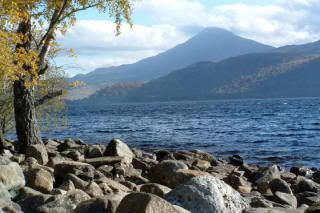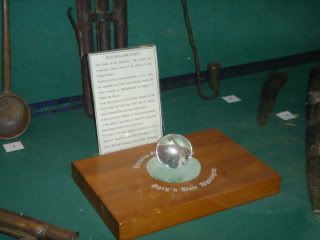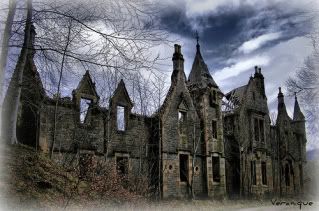
Glory Is The Reward Of Valour.
Those who had been long term readers will remember the entries I did recalling life at my Grandmother’s house, her garden, her likes, her friends. That was all written a long time ago although I did start my journal here on Blogger by repeating those entries.
I wish I could share with her the information I have gathered since her passing. She was so proud of her roots. She knew nothing of the history but was so proud of Scotland and although, due to sad circumstances, she came to England at the age of 13, she never lost her love of her Mother country and talked about it all her life.
Today I have decided I would write about the line that she came from. She was a Robertson by birth, born in Aberdeen and by tracing her line back to 1534, I have found I have ancestors from Perth, Kinnoull, Rhynd, Forgandenny, Kenmore, Pitlochry, Struan, Dull, Crieff and Fowis Wester just to name some of the places.
As a Robertson she was descended from and part of Clan Donnachaidh. Translated this means “the children of Duncan” and is pronounced “Donna-key.” This Duncan being King Duncan first. The clan descends from King Malcolm the second who reigned from 1005 to 1034 and was the last king in direct male line to descend from Kenneth MacAlpine, who united the Scots and Picts in 843 A.D.
Duncan reigned from 1034 until he was defeated in battle and killed by he of "The Scottish Play." The clan home was along the shores of Loch Rannoch and across the hills to Struan. The clan proudly claims to be Scotland’s oldest family.
The lineage traces back to Donnachaidh Remhair (Duncan the Stout) who fought for Bruce at Bannockburn and beyond him to the Celtic Earls of Atholl who were direct descendants of King Malcolm. So,they were of the Royal line that occupied the throne of Scotland in the eleventh, twelfth and thirteenth centuries. Clan Donnachaidh claim to be the sole remaining branch of that Royal house.
Duncan the Stout of Atholl was the great-great-great grandson of the third and last of those Celtic Earls of Atholl. He was also the first of the family to be known as Lord of Rannoch.

Loch Rannoch And Schiehallion
Now, we come to the magic stone. To this very day there still survives an heirloom handed down by him, one which the chiefs of the Clan have guarded through the centuries as jealously as if it had been a relic of one of the blessed saints, the miraculous Clach Na Brataich.

There are two versions as to how this object was found. The better known today is that Duncan acquired it on the road to Bannockburn. When his men stopped for a night’s sleep on the journey south, they hoisted the standard and, the next morning, as the pole was being drawn from the ground, it brought to light a ball of rock crystal, two inches in diameter and “full of magic.” The victory at Bannockburn next day is said to have been the first of many glorious engagements in which the stone played a notable part. However, that tradition goes back little more than a century.
According to Col. Alexander Robertson of Struan, the clan chief two centuries ago, he had never heard of this Bannockburn version. According to him, Duncan The Stout had imprisoned MacDougal of Lorne in his castle on the Isle of Loch Rannoch and MacDougal escaped. Duncan and his clansmen set off in pursuit but nightfall overtook them and they camped on the shore of Loch Ericht. It was there that they found the Clach Na Brataich as they were pulling the standard out the next morning.
One thing is certain. On every momentous occasion since then, no chief would have considered making a decision without first consulting the stone. In wartime, by the changing of the stone’s colour, he could tell whether the outcome was going to be good or bad. But it had peacetime uses as well. When epidemics attacked his men or cattle, they soon recovered after a drink of water into which the chief had dipped the magic ball. It was used as recently as the last century for that purpose. It was then still widely believed that, when the stone grew dim or damp, the death of the chief was imminent.
The stone was once held in a netted silken pouch which an ancestress of the Marquess of Breadalbane made for it. That has long disappeared together with the gold filigree holder.
A clan chief took the stone for sake keeping to the National Museum of Antiquities and there it remained until quite recently. Clan Donnachaidh provided themselves with a handsome clan house in the heart of their ancient homeland in Perthshire. Now, each year, the Clach Na Brataich winters in the National Museum until about the middle of March. Then when spring comes, in company with the clan curator, the stone sets off for its old familiar Highland haunts, the clan house at Bruar on the Great North Road between Struan and Blair Atholl. It can be seen there all through the summer months until the clan house closes in October and the magic stone makes the return journey to Edinburgh.
Most of the early legends are woven around Duncan. He was a noted hunter and he would frequently go wolf hunting with his men and dogs around Beinn a Chualach between Struan and Loch Rannoch. There are still three wolf heads on the armorial bearings of the clan chief and these are said to have been granted to Duncan as a reward for clearing the Atholl forests of wolves.
The next memorable event in the clan history came more than a century after Duncan’s death. King James 1 of Scotland was murdered at Perth by Sir Robert Graham and a band of accomplices. Sir Robert fled to the great forest of Ossieschailis which ran from Glenmore along the southern base of Schiechallion. Here he was eventually tracked down and captured by Robert of Atholl, the chief of Clan Donnachaidh. Out of “favour and love towards Robert for capturing this dastardly traitor”, the new king made him Baron of Struan. He also received an addition to his armorial bearings - “a savage man in chains” as a reminder that he caught the wicked Sir Robert Graham. By capturing this regicide, Robert gained a place alongside Duncan as one of the immortals of the clan.
There are other legends concerning the Clan. How a Rannoch man was so jealous of the clans’ prosperity he tried to steal the Struan bell. The loss of that would mean a decline in the Clan fortunes as would any misfortune that ever befell the magic stone.
Thirteenth and last in the direct line, and in some ways the most notable of all the chiefs of the Clan was the Jacobite, Alexander Robertson of Struan. Born around 1670, he was still a student at St. Andrew’s University when his father died and he became chief. Alexander took part in all three of the Jacobite Risings. He also built a new house on a steep mound and near the site of the present Dunalastair house. At least three houses have stood there at different times. The present one has been unoccupied since the last war and has fallen into ruin. 
The ruins of Dunalistair House.
The first house , built by Alexander Robertson of Struan, was called The Hermitage. This was a rather suitable name for a house were men were always welcome and women never. No woman, as guest or servant ever crossed its threshold for the clan chief was a lifelong bachelor and a misogynist. But he loved animals. No creature was put to death in his grounds whilst he lived.
There was little happiness for the chief in his latter years. His lands were confiscated after the last Jacobite Rising and in 1746 Government troops burned his beloved Hermitage. Two more of his houses went up in flames as well. One of them was rebuilt and he spent his last years there with his sister. It was an uncomfortable house. It was extremely cold, never plastered or lined, the rain came through the thatched roof and the cattle wandered all over the garden.
After the last Jacobite rising or rebellion, there came acts that made it illegal for the bearing of any type of weapon and it was also forbidden to wear the tartan. The British Government wanted the clans broken up once and for all.
Alexander did not die unmourned. It is said two thousand people of all ranks attended his funeral when he passed in his eighty-first year.
There where many who said that his unhappy end was inevitable. The magic stone was found to have developed a crack. Their talisman, the Clach Na Brataich - cracked! Since that day ill fortune has dogged the steps of the chiefs of the Clan. Much of the lands and property had to be sold out of the family. In 1855 a new mansion was built by the then chief, but it had to be sold less than six years later. The Barracks at the west end of Loch Rannoch was the remaining part. Until 1910 it remained the home of the chief. Even that had to be sold and by 1926 all the lands that had once belonged to the Robertsons of Struan had now passed out of their possession - all except a little high-walled enclosure. The vault of the chiefs that stands in a clump of trees on the hillside at Dunalastair.
This last resting place of those stout warriors and chiefs of old is still owned by the present clan chief, who carries on the Robertson name and the title of chief, if not the wealth and the lands.
I am very proud that, through my Grandmother, I am an distant member of this Royal and ancient line and that, by researching the family tree, our Grandsons will be left with a wealth of history.
What a great history lesson today Jeannette really enjoyed it. As you know I live very near to where you have been talking about. Forgandenny is only aboout 15 miles away. Have visited most of the places you mentioned and Lock Rannoch is one of my favourite places. Love Joan
ReplyDeleteYou have a very interesting family line. Thanks for sharing. Helen
ReplyDeletegreat entry jeannette,take care love mort xxx
ReplyDeleteIt is not common to be able to trace family lineage back to the 16th century, let alone as far back as the Battle of Bannockburn. Certainly worth passing on to following generations, Jeannette
ReplyDeleteHave been trying to join your discussion on your Blog Frog have been round and round email password about six times but cannot get in maybe thats why nobody has replied to you. Love Joan
ReplyDeleteWow! That is a LOT of history!! You should be proud--I'm glad your grandmother took so much pride in that--I bet you are too! :)
ReplyDeleteWow, that was very interesting. I enjoy reading family histories. It is quite an accomplishment to be able to trace one's ancestory so far back.
ReplyDeleteThis was absolutely fascinating ancestral reading, about Clan "Donna-key" and the incredible history of the land - I've had a love affair with Scotland since childhood and never could explain why, but one day I'll live out my dream and go "back" feel as though I've been there somehow. Thanks for taking the time to explain the immortal legends! Btw I joined your blogfrog thing so I could continue to follow you here. Don't want the widget tho, just want to be sure I have you settled in nicely and vice versa. Also caught you on Twitter which I just joined, maybe you can explain it all to me in plain English lol? Email if you want - Thanks! :-))
ReplyDeleteVery interesting read and fascinating about the stone and the value the chiefs place on it. To be able to trace your roots that far back is amazing. If I should ever have the chance to meet you in person I will be sure to curtsey. ;) You have every reason to be proud of your grandmother.
ReplyDeleteWhat a brilliant entry Jeanette..It is wonderful that you can trace your family so far back..
ReplyDeleteI am going to buck the trend...yes me...I have decided to try to blog again. I am not still sure what I am doing but mayb as days go by I will get more adventurous. I can be found on
http://sybil-dayintheifeofsybs.blogspot.com/
Love for now Sybil xx
Most interesting tale, Jeannette, that's why I have your blog in my favorites! Linda in DC
ReplyDeleteJannette,
ReplyDeleteVery interesting.Isnt it greta looking back and finding information on Family
Jeannette ,that was so interesting ,and as you say your Granny would have loved to hear what you have researched ,ah well I hope the boys will be pleased with all your endevours,your liniage is very impresive ,you are indeed a clever wee lassie ..love Jan xx
ReplyDeleteThank you for sharing your wonderful family history. You are blessed to follow the line back so far. I've not been able to so well with ours. We have alot of info on my mother's side and very little on my father's. A friend who likes to dabble in ancestrey helped me quite a bit. But her findings are not concrete. I love history especially when it involves family. Your grandson's are fortunate to have all their fine heritage put down in writing by you.
ReplyDelete'On Ya'-ma
That was really interesting, no wonder your grandmother was so proud of her Scottish homeland. You have done such a great job researching your ancestry and I know your grandmother would have been proud.
ReplyDeleteLove and Hugs
Sandra xxxx
A very interesting and informative entry, you are very lucky to have been able to trace back as far as you have. Love B x
ReplyDeleteYou always outdo yourself when writing about history and I love the research you have done. I have been doing the same with my family too, my grandmother's line had Scottish ancestry also...but I have not gotten past finding everyone in this country first then I'll have to cross the pond..lol. Thank you for your kind words on my journal I am feeling better each day and my outlook is good..love Sandi
ReplyDeleteWell done Jeannette ..somehow I missed this entry ...love Jeanxx
ReplyDeleteI too am a Robertson. Glory - Virtue - Mercy. We'll raise a cup o kindness yet for Auld Lang Syne! Thank you for posting this. Nice to read about our family!
ReplyDelete